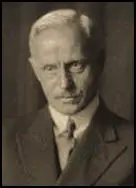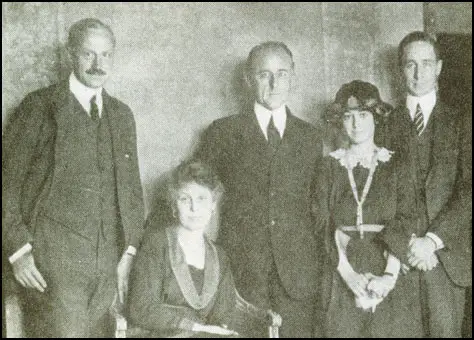Frank Crowninshield

Francis (Frank) Crowninshield, the son of Frederic Crowninshield and Helen Suzette Fairbanks Crowninshield, was born on 24th June, 1872. His father was a painter and served for two years as director of the American Academy in Rome. Crowninshield was educated in New York City where one of his fellow students was Condé Nast. It was the beginning of a life-long friendship.
Like his father, he had a strong interest in painting and he eventually became art critic of The Century Magazine. During this period he promoted the work of modern artists such as Pablo Picasso, Henri Matisse, Jules Pascin, Édouard Manet, Edgar Degas and Pierre-Auguste Renoir. He also purchased some of their work and these were later sold at a large profit.
In 1909 Condé Nast purchased a small society magazine called Vogue. He employed Crowninshield as editor and over the next few years he turned it into the country's main fashion and lifestyle magazine. It was also published in several European cities including London and Paris and it became a highly profitable aspect of Nast's growing magazine empire.
Nast also decided to establish a new magazine, Vanity Fair. He asked Crowninshield for advice. He replied: "Your magazine should cover the things people talk about... Parties, the arts, sports, theatre, humor, and so forth." Nast realized that Crowinshield was the best man to edit the new magazine that was launched in January 1914. Crowninshield told his readers: "We, as a nation have come to realize the need for more cheerfulness, for hiding a solemn face, for a fair measure of pluck, and for great good humour. Vanity Fair means to be as cheerful as anybody. It will print humour, it will look at the stage, at the arts, at the world of letters, at sport, and at the highly vitalized, electric, and diversified life of our day from the frankly cheerful angle of the optimist, or, which is much the same thing, from the mock-cheerful angle of the satirist."

Crowninshield developed a reputation for identifying good writers. In 1916 he published the first poems of Dorothy Parker. She later recalled: "Mr. Crowninshield, God rest his soul, paid twelve dollars for a small verse of mine and gave me a job on Vogue at ten dollars a week." Two years later she replaced P.G. Woodhouse as the magazine's theatre critic. Other members of staff at the time included Donald Ogden Stewart, Robert Benchley, Robert E. Sherwood and Helen Brown Norden. Crowninshield also accepted the poems, short-stories and articles from some of the most exciting young writers in the 1920s. This included Alexander Woollcott, Aldous Huxley, Edmund Wilson, Gertrude Stein, T. S. Eliot, Ferenc Molnár, Djuna Barnes, F. Scott Fitzgerald, Noël Coward and Thomas Wolfe. By 1917 the magazine had a circulation of 90,000.
In 1919 Crowninshield began taking lunch with a group of writers in the dining room at the Algonquin Hotel in New York City. The writer, Murdock Pemberton, later recalled that he owner of the hotel, Frank Case, did what he could to encourage this gathering: "From then on we met there nearly every day, sitting in the south-west corner of the room. If more than four or six came, tables could be slid along to take care of the newcomers. we sat in that corner for a good many months... Frank Case, always astute, moved us over to a round table in the middle of the room and supplied free hors d'oeuvre. That, I might add, was no means cement for the gathering at any time... The table grew mainly because we then had common interests. We were all of the theatre or allied trades." Case admitted that he moved them to a central spot at a round table in the Rose Room, so others could watch them enjoy each other's company.
This group eventually became known as the Algonquin Round Table. Other regulars at these lunches included Robert E. Sherwood, Dorothy Parker, Robert Benchley, Alexander Woollcott, Heywood Broun, Harold Ross, Donald Ogden Stewart, Edna Ferber, Ruth Hale, Franklin Pierce Adams, Jane Grant, Neysa McMein, Alice Duer Miller, Charles MacArthur, Marc Connelly, George S. Kaufman, Beatrice Kaufman , Ben Hecht, John Peter Toohey, Lynn Fontanne, Alfred Lunt and Ina Claire.

Vanity Fair published more pages of advertisements than any other American magazine. As a result Crowninshield was very keen not to upset those who helped finance the magazine. This included the theatre producer, Florenz Ziegfeld who objected to a review of a play by Dorothy Parker that featured his wife, Billie Burke: "Miss Burke is at her best in her more serious moments; in her desire to convey the girlishness of the character, she plays her lighter scenes as if she were giving an impersonation of Eva Tanguay." Parker developed a reputation for making harsh comments in her reviews and on 12th January 1920 she was sacked by Crowninshield.
Robert E. Sherwood and Robert Benchley both resigned over the sacking. As John Keats, the author of You Might as Well Live: The Life and Times of Dorothy Parker (1971): "It is difficult now to imagine a magazine of Vanity Fair's importance then truckling to Broadway producers, but the newspapers and magazines of 1920 did, and this was a sore point to the working newspapermen and theatre critics at the Round Table. They believed that if an actor was guilty of overacting, it was no more and no less than a critic's duty to report that he was - producers be damned. Furthermore, in this case, Vanity Fair's position seemed to be one of accepting a complaint from an advertiser as sufficient excuse to fire an employee with no questions asked, and it was the injustice of this position that led Mr Benchley and Mr Sherwood to tell Mr Crowninshield that if he was going to fire Mrs Parker, they were quitting."
In 1921 Crowninshield moved in with Condé Nast. Crowninshield commented: "I suppose people thought we were fairies." Amy Fine Collins gave another explanation: "the situation providing the editor with posher accommodations than he could otherwise have afforded, and his boss with access to Crowninshield's far-flung and comprehensive social connections." Crowninshield, who never married, told his friend, Alexander Woollcott: "Married men make very poor husbands."
Crowninshield met Clare Boothe in 1929. At the interview he asked her to come back in a week's time with 100 suggestions suitable for publication in Vanity Fair. On the result of this exercise he gave her a job on the magazine. Clare asked if that meant her ideas were good ones. Crowninshield replied: "No, my child. Some of them are perfectly dreadful. but two at least are excellent. And one good idea a week is about all a magazine should expect from a novice assistant editor."
One of Boothe's first assignments was to write captions for its popular feature, We Nominate for the Hall of Fame . This included articles on people like Thomas Mann, Ernest Hemingway, Walter Gropius, Louis Bromfield and Pablo Picasso. In August, 1930, she introduced a new feature, We Nominate for Oblivion . Her targets included politicians such as Reed Smott ("because his chief qualifications for holding the position of Chairman of the Senate Finance Committee is that he is an apostle in the Mormon Church of Utah and doesn't count on his fingers") and Smith W. Brookhart ("because he has made political capital out of snitching on those of his hosts who serve alcohol").
Vanity Fair suffered during the Great Depression from falling advertising revenue. Condé Nast announced in December 1935 that the magazine would be merged with Vogue (circulation 156,000) as of the March 1936 issue. Amy Fine Collins has argued: "A victim of the Depression, the magazine lost advertisers - whose existence Crowninshield had always ignored anyway. But Vanity Fair had also fallen out of sync with the times. By the 30s, with the economy and Fascism at the forefront of readers' minds, subscribers gravitated more to no-nonsense news coverage."
Frank Crowninshield died on 28th December, 1947.
Primary Sources
(1) John Keats, You Might as Well Live: The Life and Times of Dorothy Parker (1971)
Robert Benchley said that Frank Crowninshield had called Mrs Parker into his office that morning and told her that a suggestion had come to him from the publisher, Condé Nast, to fire her. The reason was, Mr Crowninshield had said, that she had panned three Broadway plays, and the producers of these plays complained to the publisher that they had been unfairly treated...
It is difficult now to imagine a magazine of Vanity Fair's importance then truckling to Broadway producers, but the newspapers and magazines of 1920 did, and this was a sore point to the working newspapermen and theatre critics at the Round Table. They believed that if an actor was guilty of overacting, it was no more and no less than a critic's duty to report that he was - producers be damned. Furthermore, in this case, Vanity Fair's position seemed to be one of accepting a complaint from an advertiser as sufficient excuse to fire an employee with no questions asked, and it was the injustice of this position that led Mr Benchley and Mr Sherwood to tell Mr Crowninshield that if he was going to fire Mrs Parker, they were quitting.
(2) Amy Fine Collins, Vanity Fair: The Early Years, 1914–1936 (7th July, 2011)
Once upon a time, before the income tax, the Great War, and Prohibition, Mr. Condé Nast bought a magazine called Dress, a potential rival to his four-year-old Vogue. A few months later, in 1913, he paid $3,000 for a musty British social, literary, and political review titled Vanity Fair, named after both the sinful place in John Bunyan's 17th-century allegory The Pilgrim's Progress and William Makepeace Thackeray's 19th-century satirical novel. Crossbreeding his two acquisitions, Nast created Dress and Vanity Fair, a hydra-headed flop. To salvage the situation, Nast sought advice from the most cultivated, elegant, and endearing man in publishing, if not Manhattan, Frank Crowninshield.
The upper-crust aesthete - who, earlier the same year, had helped organize the landmark Armory Show, a succés de scandale which introduced Cubism to the American public - offered a remarkably simple solution. "Your magazine should cover the things people talk about," Crowninshield told Mr. Nast. "Parties, the arts, sports, theatre, humor, and so forth." Nast at once anointed Crowninshield editor, and agreeing to ditch the first half of the old title, the publishing tycoon launched Vanity Fair in January 1914. In his first editor's letter that March, Crowninshield confidently proclaimed that "young men and young women, full of courage, originality, and genius, are everywhere to be met with."
From 1921 to 1927, Nast and Crowninshield actually roomed together in a Park Avenue duplex - "I suppose people thought we were fairies," the publisher said - a situation providing the editor with posher accommodations than he could otherwise have afforded, and his boss with access to Crowninshield's far-flung and comprehensive social connections....
What, then, killed Vanity Fair, dead at 22 in the year 1936? A victim of the Depression, the magazine lost advertisers - whose existence Crowninshield had always ignored anyway. But Vanity Fair had also fallen out of sync with the times. By the 30s, with the economy and Fascism at the forefront of readers' minds, subscribers gravitated more to no-nonsense news coverage than to arch V.F. pictorials such as "Who's Zoo?," which likened Mussolini's face to a monkey's. Nast contemplated emasculating Vanity Fair by turning it into a magazine called Beauty. But instead he folded it, along with Crowninshield, into Vogue. How bewildered the erudite Crownie would be to learn that, nine decades after his installation as editor - and some 20 years after Vanity Fair's resurrection into its current incarnation - today's reading public is less familiar with Bunyan and Thackeray than with the periodical that once promised to "ignite a dinner party at fifty yards."
